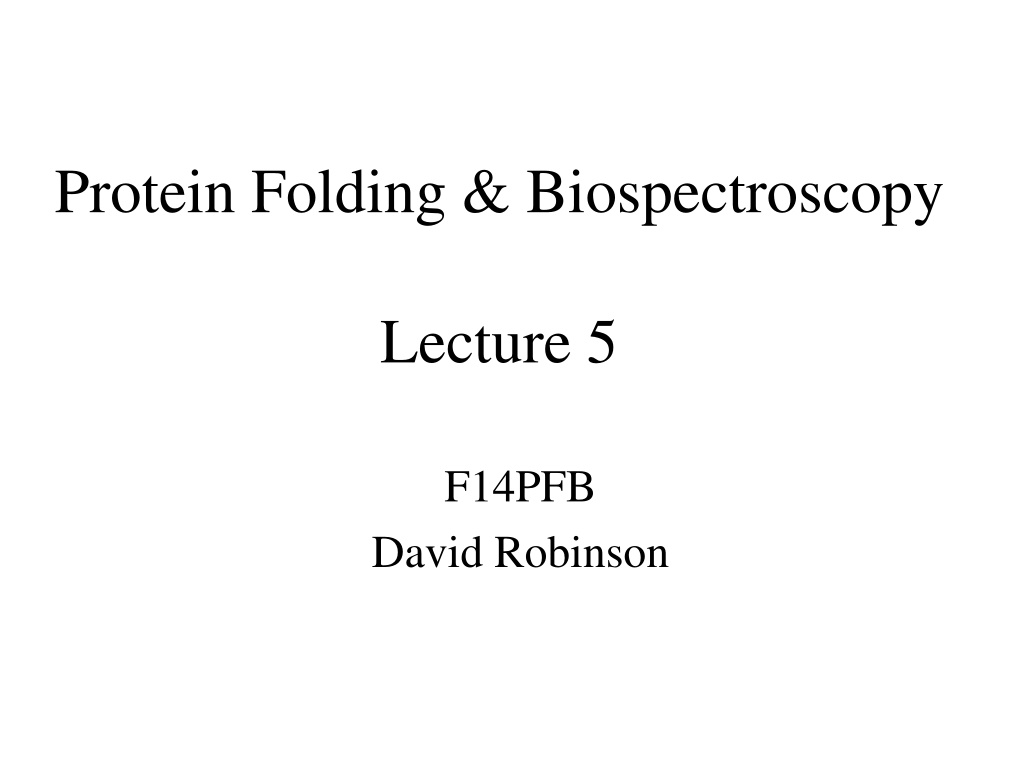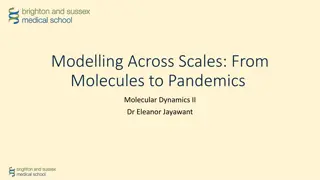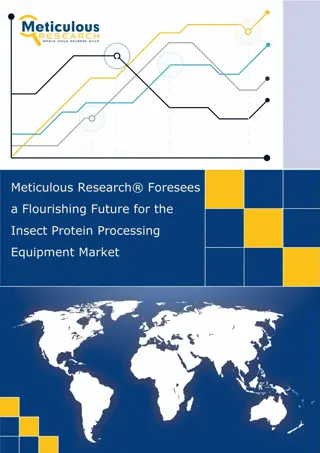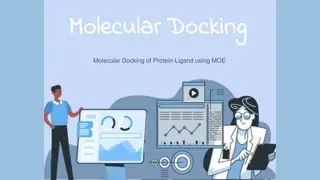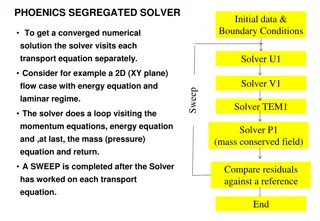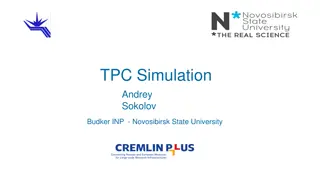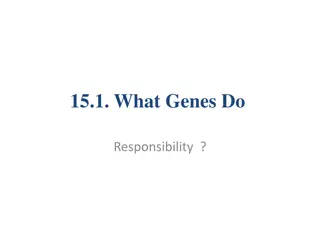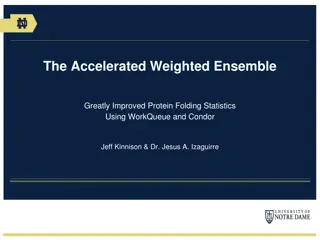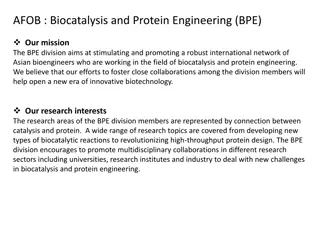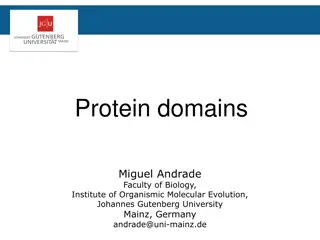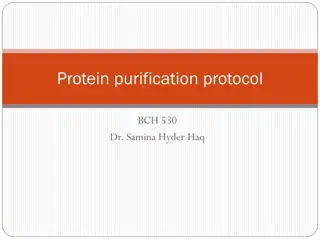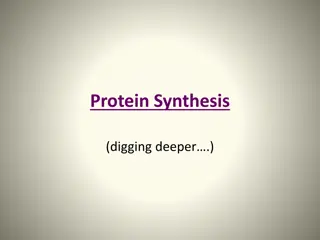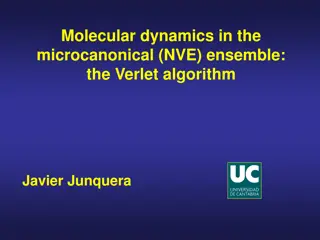Protein Folding and Molecular Dynamics Simulations
The intricate world of protein folding and classical molecular dynamics simulations, essential for understanding biomolecular interactions and dynamics. Discover the science behind molecular dynamics, its applications in simulating particle systems of various scales, and the uses of simulations in exploring biopolymer dynamics, binding energies, and stability. Dive into the theoretical foundations of molecular mechanics and the role of energy minimization in studying complex molecular assemblies. Uncover the power of free energy simulations in estimating binding energies, protein stability, and pKa calculations."
Download Presentation

Please find below an Image/Link to download the presentation.
The content on the website is provided AS IS for your information and personal use only. It may not be sold, licensed, or shared on other websites without obtaining consent from the author.If you encounter any issues during the download, it is possible that the publisher has removed the file from their server.
You are allowed to download the files provided on this website for personal or commercial use, subject to the condition that they are used lawfully. All files are the property of their respective owners.
The content on the website is provided AS IS for your information and personal use only. It may not be sold, licensed, or shared on other websites without obtaining consent from the author.
E N D
Presentation Transcript
Protein Folding & Biospectroscopy Lecture 5 F14PFB David Robinson
Protein Folding 1. Introduction 2. Protein Structure 3. Interactions 4. Protein Folding Models 5. Biomolecular Modelling 6. Bioinformatics
Classical Molecular Dynamics Simulations of Proteins
everything that living things do can be understood in terms of the jigglings and wigglings of atoms. The Feynman Lectures in Physics vol. 1, 3-6 (1963)
What is Molecular Dynamics? The science of simulating the motions of a system of particles (Karplus & Petsko) From systems As small as an atom As large as a galaxy Equations of motion Time evolution
Essential Elements Knowledge of the interaction potential for the particles Forces Many particles impossible analytically One particle easy analytically Classical Newtonian equations of motion Many particle systems simulation Maxwell-Boltzmann averaging process for thermodynamic properties: time averaging
Basis: Molecular Mechanics Theoretical foundation Potential energy functions Energy minimization Molecular dynamics
Uses of simulation & modelling Conformational searching with MD and minimization Exploration of biopolymer fluctuations and dynamics & kinetics MD as an ensemble sampler
Free energy simulations Example applications Energy minimization as an estimator of binding free energies Protein stability Approximate association free energy of molecular assemblies Approximate pKa calculations
Theoretical Foundations 1. Force field parameters for families of chemical compounds System modelled using Newton s equations of motion Examples: hard spheres simulations (Alder & Wainwright, 1959); Liquid water (Rahman & Stillinger, 1970); BPTI (McCammon & Karplus, 1976); Villin headpiece (Duan & Kollman, 1998) 2. 3.
Protein Motion Protein motions of importance are torsional oscillations about the bonds that link groups together Substantial displacements of groups occur over long time intervals Collective motions either local (cage structure) or rigid-body (displacement of different regions) What is the importance of these fluctuations for biological function?
Effect of fluctuations Thermodynamics: equilibrium behaviour important; e.g., energy of ligand binding Dynamics: displacements from average structure important; e.g., local sidechain motions that act as conformational gates in oxygen transport myoglobin, enzymes, ion channels
Local Motions 0.01-5 , 1 fs -0.1s Atomic fluctuations Small displacements for substrate binding in enzymes Energy source for barrier crossing and other activated processes (e.g., ring flips) Sidechain motions Opening pathways for ligand (myoglobin) Closing active site Loop motions Disorder-to-order transition as part of virus formation
Rigid-Body Motions 1-10 , 1 ns 1 s Helix motions Transitions between substates (myoglobin) Hinge-bending motions Gating of active-site region (liver alcohol dehydrogenase) Increasing binding range of antigens (antibodies)
Large Scale Motion > 5 , 1 microsecond 10000 s Helix-coil transition Activation of hormones Protein folding transition Dissociation Formation of viruses Folding and unfolding transition Synthesis and degradation of proteins Role of motions sometimes only inferred from two or more conformations in structural studies
Typical Time Scales .... Bond stretching: Elastic vibrations: Rotations of surface sidechains: Hinge bending: Rotation of buried side chains: Protein folding: 10-14 - 10-13 sec. 10-12 - 10-11 sec. 10-11 - 10-10 sec. 10-11 - 10-7 sec. 10-4 - 1 sec. 10-6 - 102 sec. Timescale in MD: A Typical timestep in MD is 1 fs (10-15 sec) (ideally 1/10 of the highest frequency vibration)
Ab initio protein folding simulation Physical time for simulation Typical time-step size Number of MD time steps Atoms in a typical protein and water simulation Approximate number of interactions in force calculation Machine instructions per force calculation Total number of machine instructions BlueGene capacity (floating point operations per second) 10 4 seconds 10 15 seconds 1011 32,000 109 1000 1023 1 petaflop (1015) Blue Gene will need 3 years to simulate 100 sec. [ http://www.research.ibm.com/bluegene/ ]
Empirical Force Fields and Molecular Mechanics describe interaction of atoms or groups the parameters are empirical , i.e. they are dependent on others and have no direct intrinsic meaning
Bond stretching Approximation of the Morse potential by an elastic spring model Hooke s law as reasonable approximation close to reference bond length l0 k : Force constant l : distance l k ( ) 2 = ( ) V l l l 0 2
Angle Bending Deviation from angles from their reference angle 0often described by Hooke s law: =k ( ) 2 ( ) V 0 2 k : Force constant : bond angle Force constants are much smaller than those for bond stretching
Torsional Terms Hypothetical potential function for rotation around a chemical bond: V ( ) ( = + n ) 1 cos n V 2 Vn: barrier height n : multiplicity (e.g. n=3) : torsion angle : phase factor Need to include higher terms for non-symmetric bonds (i.e. to distinguish trans, gauche conformations)
Electrostatic interactions Electronegative elements attract electrons more than less electronegative elements Unequal charge distribution is expressed by fractional charges Electrostatic interaction often calculated by Coulomb s law: q + + q q N N = i 1 i j r = V r 4 = + 1 j i 0 ij -
Example for a (very) simple Force Field: 2 k 2 ( ) bonds = i V l l 0 , i i 2 k 2 ( ) angles + i 0 , i i V ( ( ) ) torsions + + 1 cos N n 2 12 6 q q N N = i 1 ij ij i j r + + 4 ij 4 r r = + 1 j i 0 ij ij ij
Molecular Mechanics - Energy Minimization The energy of the system is minimized. The system tries to relax Typically, the system relaxes to a local minimum (LM).
Molecular Dynamics (MD) In molecular dynamics, energy is supplied to the system, typically using a constant temperature (i.e. constant average constant kinetic energy).
Newtons Laws of Motion 1. A body maintains its state of rest or of uniform motion in a straight line, unless acted upon by a force. 2. The applied force is equal to the rate of change of momentum. 3. Two isolated bodies acting upon each other experience equal and opposite forces.
Molecular Dynamics (MD) Use Newtonian mechanics to calculate the net force and acceleration experienced by each atom. Each atom i is treated as a point with mass mi and fixed charge qi Determine the force Fi on each atom: d V = = F m a i i i d r i Use positions and accelerations at time t (and positions from t - t) to calculate new positions at time t + t
(a) consisting of 10 amino acid residues. State and justify any assumptions that you make. (b) Calculate the number of pairwise interactions which need to be evaluated to calculate the energy of a 10-residue peptide, stating any assumptions you make. If a computer capable of calculating one million pairwise interactions per second is used, and the time to perform a systematic search of all conformations is one structure per 10-13 seconds, estimate both the simulation time required to fold the peptide and the time it would take to calculate the energy of all the conformers. Estimate the total number of possible structures of a polypeptide
